Do you know that flowers are not just beautiful but also carry significant meanings? From roses to lilies, each flower has a unique message to convey.
However, when it comes to flowers that start with V, it’s quite rare to come across them. But why should we care about them?
Well, not only do they make for a unique gift, but they also hold special meanings that could inspire you or those around you.
In this guide, we’ll explore some of the most exquisite and intriguing flowers that start with V and uncover their hidden significance. So, let’s dive in!
Keep Reading:
- Flowers That Start With Q
- Flowers That Start With R
- Flowers That Start With S
- Flowers That Start With T
- Flowers That Start With U
List Of Flowers That Start With V
1. Virginia Sweetspire
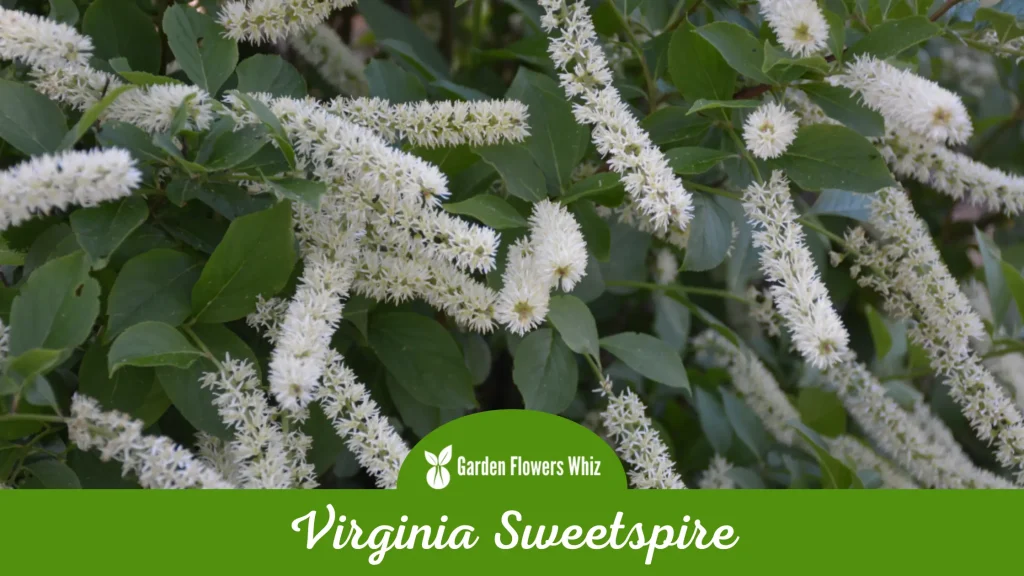
The Virginia Sweetspire, scientifically known as Itea virginica, is a deciduous shrub that is native to the southeastern United States. It is an attractive plant that is renowned for its abundant clusters of fragrant, small white flowers that bloom in late spring or early summer.
The Virginia Sweetspire is also appreciated for its stunning fall foliage, which turns from green to shades of orange, red, and purple, making it an ideal addition to a fall garden.
The plant can reach a height of up to six feet and a spread of up to eight feet, making it an excellent choice for filling in large spaces in a garden.
The Virginia Sweetspire thrives in moist to wet soils and prefers partial shade to full sun. It is relatively low maintenance, requiring only occasional pruning to maintain its shape and size.
This hardy and versatile shrub is also highly tolerant of pests and diseases, making it an ideal choice for gardeners looking for a plant that is easy to care for and produces a bountiful display of flowers and foliage.
2. Virginia Bluebells

The Virginia Bluebells, also known as Mertensia virginica, is a beautiful spring-blooming perennial wildflower that is native to eastern North America.
It is named for its unique bell-shaped flowers that range in color from pale blue to pink and bloom in clusters atop tall stems. The Virginia Bluebells typically bloom in early spring, making them an excellent choice for brightening up a garden after a long winter.
This wildflower can grow up to two feet tall and spread to form large colonies. It thrives in moist to wet soil and prefers partial shade to full sun, making it an ideal choice for woodland gardens or along the edges of ponds or streams.
The Virginia Bluebells are also a favorite among pollinators such as bees and butterflies, making it a great choice for gardeners looking to attract wildlife.
Virginia Bluebells are relatively low maintenance, requiring only occasional pruning to remove any dead or damaged stems. They are hardy and long-lived, making them a wonderful addition to any garden for years to come.
3. Viper’s Bugloss
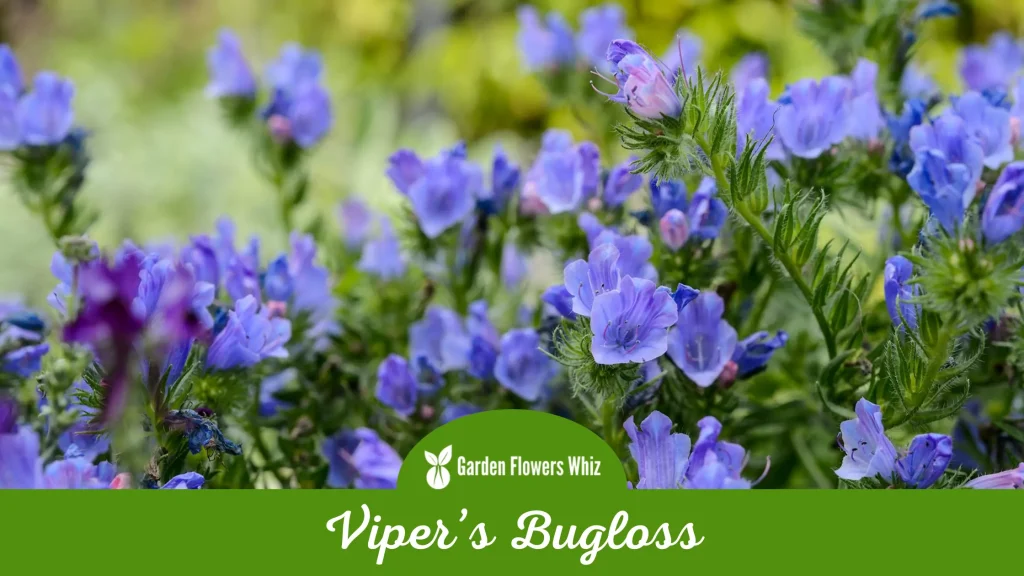
Viper’s Bugloss, also known as Echium vulgare, is a unique and striking wildflower that is native to Europe and western Asia but has been naturalized in other parts of the world, including North America.
It is named for the resemblance of its flowers to the head of a viper, with bright blue to purple, tubular flowers that bloom in spikes atop hairy stems.
The plant typically grows to a height of two to three feet and blooms in midsummer, attracting bees, butterflies, and other pollinators to its nectar-rich flowers.
Viper’s Bugloss is a hardy plant that is tolerant of poor soil conditions and drought. It prefers full sun to partial shade and can be grown in a variety of garden settings, from wildflower meadows to rock gardens.
Its unique appearance and ability to attract pollinators make it a popular choice for gardeners looking to add a touch of wildness to their landscape.
4. Violet

Violets are a group of flowering plants that belong to the genus Viola, which includes over 500 different species. These delicate and beautiful plants are native to many regions around the world and have been cultivated for their ornamental value for centuries.
Violets are well-known for their distinctive flowers, which range in color from deep purple to shades of blue, pink, white, and yellow.
The flowers have a sweet and subtle fragrance that adds to their allure. Violets are relatively low-growing plants that prefer cool, moist, and shaded environments.
They can be grown in a variety of garden settings, including rock gardens, borders, and containers. Some species of violets are also edible and have been used in salads, teas, and other culinary preparations.
5. Viola Tri-colour
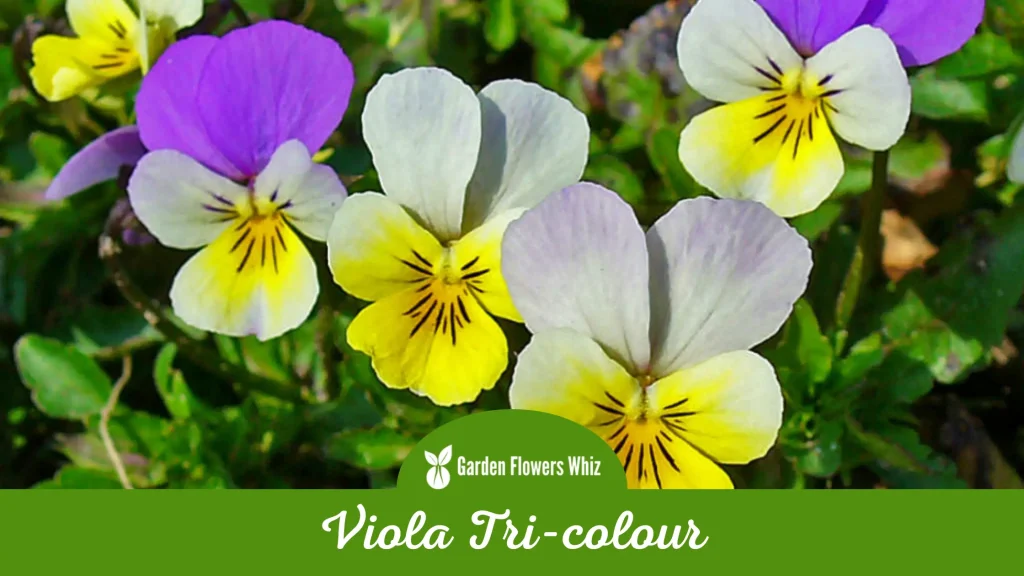
Viola tricolor, commonly known as Heartsease or Wild Pansy, is a delightful little flower that is native to Europe and parts of Asia. It is a low-growing annual or perennial that produces small, delicate flowers that have three distinct colors: yellow, purple, and white.
The flowers bloom from spring to summer and have a sweet fragrance that adds to their charm. Heartsease is a hardy plant that thrives in a variety of soil types and can grow in both sun and partial shade.
It is relatively easy to grow and is often used in rock gardens, borders, and containers.
6. Viola x Wittrockiana

Viola x wittrockiana, commonly known as Pansy, is a popular and widely cultivated flower that is a hybrid of several Viola species. It is known for its large, showy flowers that come in a wide range of colors, including purple, yellow, white, and orange, as well as bi-color and multi-color combinations.
The flowers have a characteristic “face” with a dark center and a contrasting border, giving them a distinctive appearance. Pansies are cool-season annuals that can bloom in spring, fall, and even winter in some regions.
They prefer cool temperatures and can tolerate light frost, making them a great choice for cooler climates. Pansies are also easy to grow and care for, making them a popular choice for both beginner and experienced gardeners.
They can be planted in containers, hanging baskets, borders, and mass plantings.
7. Vinca Minor
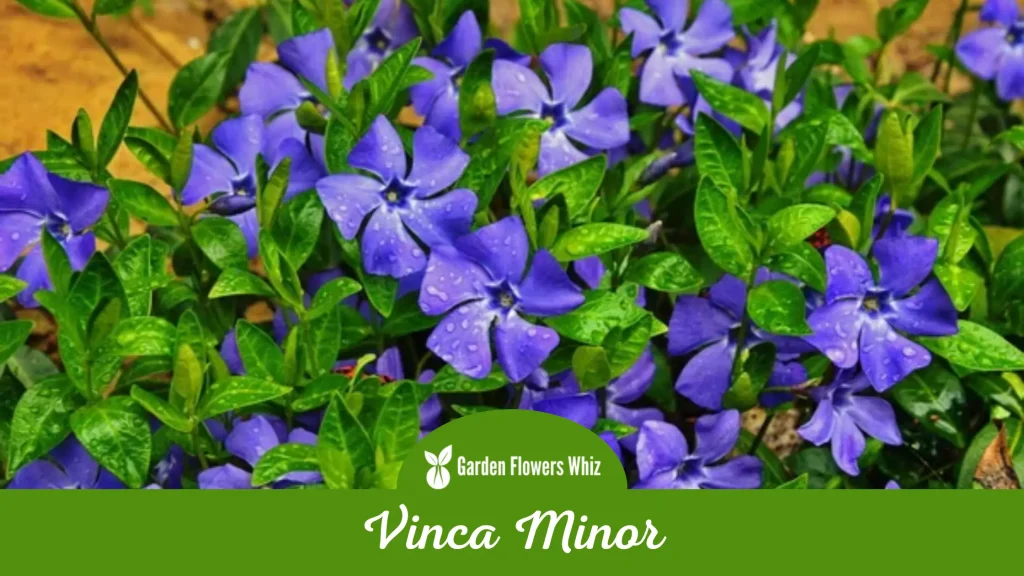
Vinca minor, commonly known as Periwinkle, is a popular evergreen groundcover that is native to Europe and western Asia. It is a low-growing plant that produces attractive, shiny green foliage and delicate blue-purple flowers that bloom from spring to summer.
The flowers are about an inch in diameter and have five petals with a distinctive white center. Periwinkle is a hardy plant that is tolerant of a range of soil conditions and can grow in both sun and shade, making it a great choice for a variety of garden settings.
It is often used to cover large areas, control erosion, and add color to rock gardens, borders, and containers.
Its lovely blue-purple flowers and evergreen foliage make it a charming addition to any garden, while its hardiness and ability to grow in a range of conditions make it a practical choice for many landscaping projects.
8. Viburnum
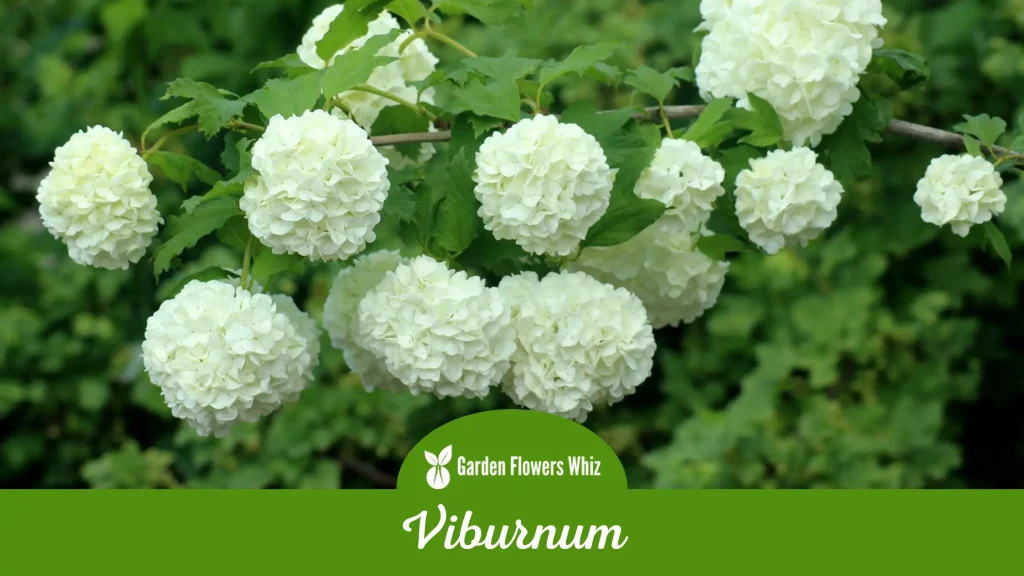
Viburnum is a genus of shrubs and small trees that are popular for their ornamental value and hardiness. They are native to regions around the world, including Asia, Europe, and North America.
Viburnum plants typically produce clusters of small, fragrant flowers in shades of white, pink, or red, which bloom in spring and early summer.
Some varieties also produce attractive foliage that turns red or purple in the fall. Viburnums are hardy plants that can tolerate a range of growing conditions, making them a popular choice for gardens and landscapes.
They can be grown in the sun or shade, and they are tolerant of a range of soil types. Viburnums are also low-maintenance plants, requiring little pruning or other care.
Their fragrant flowers, colorful foliage, and edible fruit make them a popular choice for gardens, while their hardiness and low-maintenance requirements make them a practical choice for many landscaping projects.
9. Veronica Incana
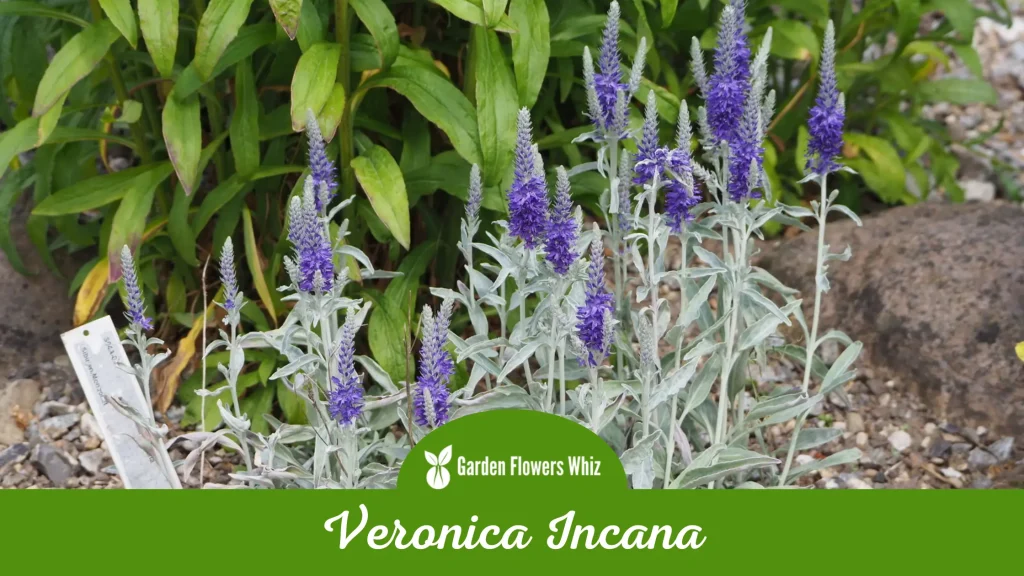
Veronica incana, commonly known as Woolly Speedwell, is a charming herbaceous perennial that is native to Europe and western Asia. It is a low-growing plant that produces soft, woolly grey-green foliage and delicate spikes of bright blue or pink flowers in late spring and early summer.
The flowers are attractive to bees and other pollinators, making this plant a great choice for gardens and pollinator-friendly landscapes.
Woolly Speedwell is a hardy plant that is tolerant of a range of growing conditions, making it a popular choice for gardens and landscapes.
It can grow in the sun or partial shade and is tolerant of a range of soil types. Woolly Speedwell is also easy to care for, requiring little pruning or other maintenance.
Woolly Speedwell is an attractive and low-maintenance plant that offers both ornamental and ecological benefits.
Its colorful flowers and woolly foliage make it a charming addition to any garden, while its attractiveness to pollinators makes it a valuable plant for those interested in supporting local ecosystems.
10. Verbena

Verbena is a popular and versatile plant that is commonly grown in gardens and landscapes around the world. It is a herbaceous perennial that produces clusters of small, colorful flowers in shades of purple, pink, red, and white.
The flowers are attractive to butterflies and other pollinators, making Verbena a great choice for gardens and pollinator-friendly landscapes.
Verbena is a hardy plant that can tolerate a range of growing conditions, making it a popular choice for gardens and landscapes. It can grow in full sun or partial shade and is tolerant of a range of soil types.
Verbena is also easy to care for, requiring little pruning or other maintenance. Its colorful flowers and hardiness make it a popular choice for gardens, while its attractiveness to pollinators and medicinal properties make it a valuable plant for those interested in supporting local ecosystems and natural health remedies.
In Summary
Flowers that start with V may not be the most common or popular flowers, but they are certainly worth exploring. From the vibrant viola to the delicate verbena, these flowers have their own unique charm and beauty.

Stacey Hernandez is a seasoned botanist with over 16 years of experience in the field. Her passion for plants and their intricate workings began at a young age, and she has since devoted her life to studying and understanding them.
Stacey’s expertise extends to a wide range of plant species, from delicate flowers to towering trees. As the founder of Garden Flowers Whiz, Stacey has created a platform for plant enthusiasts to seek guidance and advice.
Her website is a go-to resource for those seeking answers to their gardening dilemmas, whether it’s how to care for a particular plant or which species to choose for a specific climate.
